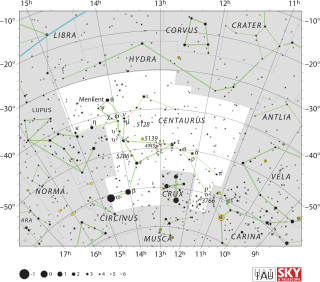
Centaurus is a bright constellation in the southern sky. One of the largest constellations, Centaurus was included among the 48 constellations listed by the 2nd-century astronomer Ptolemy, and it remains one of the 88 modern constellations. In Greek mythology, Centaurus represents a centaur; a creature that is half human, half horse. Notable stars include Alpha Centauri, the nearest star system to the Solar System, its neighbour in the sky Beta Centauri, and V766 Centauri, one of the largest stars yet discovered. The constellation also contains Omega Centauri, the brightest globular cluster as visible from Earth and the largest identified in the Milky Way, possibly a remnant of a dwarf galaxy.
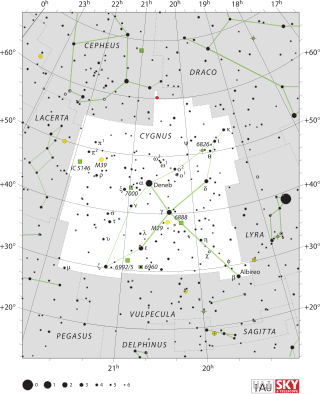
Cygnus is a northern constellation on the plane of the Milky Way, deriving its name from the Latinized Greek word for swan. Cygnus is one of the most recognizable constellations of the northern summer and autumn, and it features a prominent asterism known as the Northern Cross. Cygnus was among the 48 constellations listed by the 2nd century astronomer Ptolemy, and it remains one of the 88 modern constellations.

Fornax is a constellation in the southern celestial hemisphere, partly ringed by the celestial river Eridanus. Its name is Latin for furnace. It was named by French astronomer Nicolas Louis de Lacaille in 1756. Fornax is one of the 88 modern constellations.

Microscopium is a minor constellation in the southern celestial hemisphere, one of twelve created in the 18th century by French astronomer Nicolas-Louis de Lacaille and one of several depicting scientific instruments. The name is a Latinised form of the Greek word for microscope. Its stars are faint and hardly visible from most of the non-tropical Northern Hemisphere.
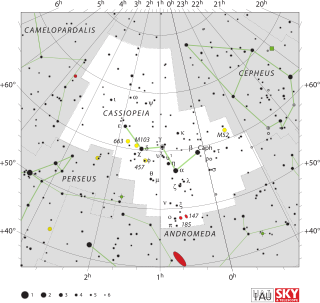
Cassiopeia is a constellation and asterism in the northern sky named after the vain queen Cassiopeia, mother of Andromeda, in Greek mythology, who boasted about her unrivaled beauty. Cassiopeia was one of the 48 constellations listed by the 2nd-century Greek astronomer Ptolemy, and it remains one of the 88 modern constellations today. It is easily recognizable due to its distinctive 'W' shape, formed by five bright stars.

Perseus is a constellation in the northern sky, named after the Greek mythological hero Perseus. It is one of the 48 ancient constellations listed by the 2nd-century astronomer Ptolemy, and among the 88 modern constellations defined by the International Astronomical Union (IAU). It is located near several other constellations named after ancient Greek legends surrounding Perseus, including Andromeda to the west and Cassiopeia to the north. Perseus is also bordered by Aries and Taurus to the south, Auriga to the east, Camelopardalis to the north, and Triangulum to the west. Some star atlases during the early 19th century also depicted Perseus holding the disembodied head of Medusa, whose asterism was named together as Perseus et Caput Medusae; however, this never came into popular usage.
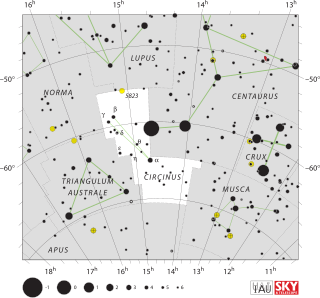
Circinus is a small, faint constellation in the southern sky, first defined in 1756 by the French astronomer Nicolas-Louis de Lacaille. Its name is Latin for compass, referring to the drafting tool used for drawing circles. Its brightest star is Alpha Circini, with an apparent magnitude of 3.19. Slightly variable, it is the brightest rapidly oscillating Ap star in the night sky. AX Circini is a Cepheid variable visible with the unaided eye, and BX Circini is a faint star thought to have been formed from the merger of two white dwarfs. Two sun-like stars have planetary systems: HD 134060 has two small planets, and HD 129445 has a Jupiter-like planet. Supernova SN 185 appeared in Circinus in 185 AD and was recorded by Chinese observers. Two novae have been observed more recently, in the 20th century.

Lacerta is one of the 88 modern constellations defined by the International Astronomical Union. Its name is Latin for lizard. A small, faint constellation, it was defined in 1687 by the astronomer Johannes Hevelius. Its brightest stars form a "W" shape similar to that of Cassiopeia, and it is thus sometimes referred to as 'Little Cassiopeia'. It is located between Cygnus, Cassiopeia and Andromeda on the northern celestial sphere. The northern part lies on the Milky Way.
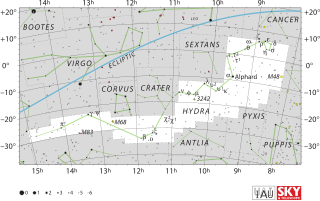
Hydra is the largest of the 88 modern constellations, measuring 1303 square degrees, and also the longest at over 100 degrees. Its southern end borders Libra and Centaurus and its northern end borders Cancer. It was included among the 48 constellations listed by the 2nd century astronomer Ptolemy. Commonly represented as a water snake, it straddles the celestial equator.
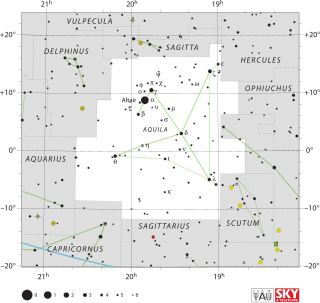
Aquila is a constellation on the celestial equator. Its name is Latin for 'eagle' and it represents the bird that carried Zeus/Jupiter's thunderbolts in Greek-Roman mythology.
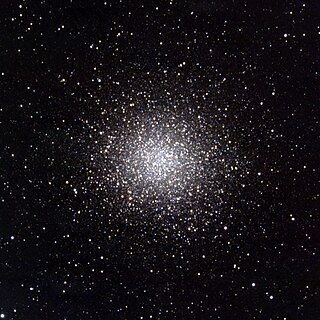
Messier 14 is a globular cluster of stars in the constellation Ophiuchus. It was discovered by Charles Messier in 1764.

The Jewel Box is an open cluster in the constellation Crux, originally discovered by Nicolas Louis de Lacaille in 1751–1752. This cluster was later named the Jewel Box by John Herschel when he described its telescopic appearance as "...a superb piece of fancy jewellery". It is easily visible to the naked eye as a hazy star some 1.0° southeast of the first-magnitude star Mimosa. This hazy star was given the Bayer star designation "Kappa Crucis", from which the cluster takes one of its common names. The modern designation Kappa Crucis has been assigned to one of the stars in the base of the A-shaped asterism of the cluster

Messier 7 or M7, also designated NGC 6475 and sometimes known as the Ptolemy Cluster, is an open cluster of stars in the constellation of Scorpius. The cluster is easily detectable with the naked eye, close to the "stinger" of Scorpius. With a declination of −34.8°, it is the southernmost Messier object.
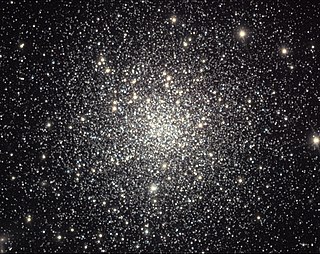
Messier 12 or M 12 is a globular cluster in the constellation of Ophiuchus. It was discovered by the French astronomer Charles Messier on May 30, 1764, who described it as a "nebula without stars". In dark conditions this cluster can be faintly seen with a pair of binoculars. Resolving the stellar components requires a telescope with an aperture of 8 in (20 cm) or greater. In a 10 in (25 cm) scope, the granular core shows a diameter of 3′ (arcminutes) surrounded by a 10′ halo of stars.

Messier 23, also known as NGC 6494, is an open cluster of stars in the northwest of the southern constellation of Sagittarius. It was discovered by Charles Messier in 1764. It can be found in good conditions with binoculars or a modestly sized telescope. It is in front of "an extensive gas and dust network", which there may be no inter-association. It is within 5° the sun's position so can be occulted by the moon.
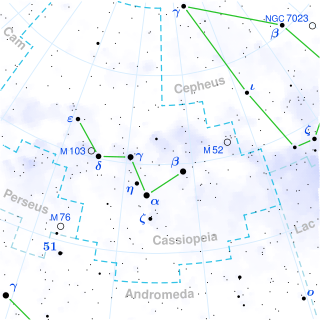
Phi Cassiopeiae is a star in the constellation Cassiopeia. φ Cassiopeiae is a multiple star with a combined apparent magnitude of +4.95. The two brightest components are A and C, sometimes called φ1 and φ2 Cas. φ Cas A is an F0 bright supergiant of magnitude 4.95 and φ Cas C is a 7.08 magnitude B6 supergiant at 134".
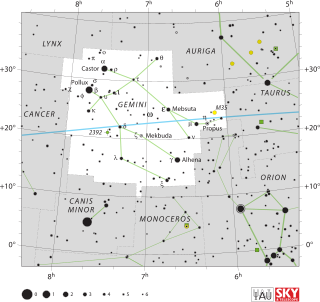
Gemini is one of the constellations of the zodiac and is located in the northern celestial hemisphere. It was one of the 48 constellations described by the 2nd century AD astronomer Ptolemy, and it remains one of the 88 modern constellations today. Its name is Latin for twins, and it is associated with the twins Castor and Pollux in Greek mythology. Its old astronomical symbol is (♊︎).
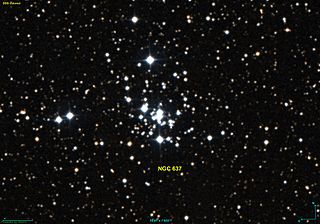
NGC 637 is an open cluster of stars in the northern constellation of Cassiopeia, positioned about 1.5° to the WNW of the star Epsilon Cassiopeiae. The cluster was discovered on 9 November 1787 by German-born English astronomer William Herschel. It is located in the Perseus Arm of the Milky Way, at a distance of approximately 7.045 kilolight-years from the Sun. The cluster is small but compact, and is readily visible in a small telescope.
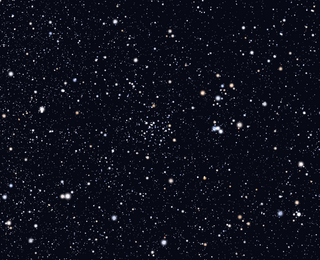
NGC 6811 is an open cluster in the constellation of Cygnus, near the constellation of Lyra. It has an angular size half that of the full Moon and includes about 1000 stars of roughly similar magnitude. It has also been called "The Hole in the Cluster" because of its dark center.
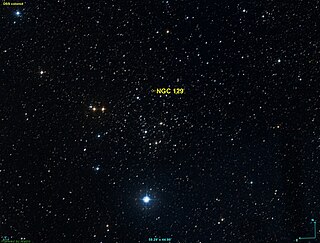
NGC 129 is an open cluster in the constellation Cassiopeia. It was discovered by William Herschel in 1788. It is located almost exactly halfway between the bright stars Caph and γ Cassiopeiae. It is large but not dense and can be observed by binoculars, through which the most obvious component is a small triangle of stars of magnitude 8 and 9, located in the center of the cluster.






















